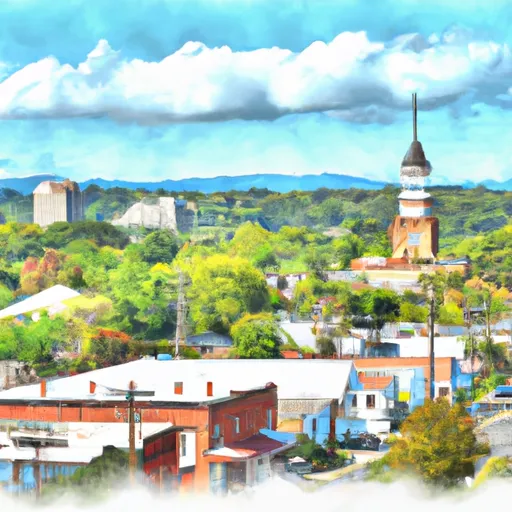-
 Snoflo Premium
Snoflo Premium
Get unlimited access to all our content
With no Ad interruptions! - Start Your Free Trial Login with existing account
Mount-Vernon
Eden Index
Climate
8.3
•
Recreation
0.6
•
Community
1.9
•
Safeguard
4.0/10

Mount-Vernon is a charming city located in central Georgia, known for its pleasant climate, diverse hydrology constituents, and abundant outdoor recreation opportunities. The region experiences a humid subtropical climate, characterized by hot summers and mild winters. Average temperatures range from the mid-90s (°F) in the summer to the mid-30s in the winter, with occasional snowfall.
Hydrologically, Mount-Vernon is blessed with several water bodies, including the Oconee and Ocmulgee rivers, providing opportunities for fishing, boating, and water sports enthusiasts. The surrounding countryside is dotted with numerous lakes and ponds, attracting nature lovers and birdwatchers.
Outdoor recreation enthusiasts will appreciate the vast array of activities available. The city is surrounded by picturesque parks and nature reserves, offering opportunities for hiking, camping, and wildlife observation. The nearby Altamaha Wildlife Management Area provides hunting and fishing possibilities.
Additionally, golfers can enjoy the challenging fairways and scenic landscapes of the area's beautifully maintained golf courses. Overall, Mount-Vernon offers a delightful blend of natural beauty and recreational activities for visitors and residents alike, making it an ideal destination for outdoor enthusiasts.
What is the Eden Index?
The Snoflo Eden Index serves as a comprehensive rating system for regions, evaluating their desirability through a holistic assessment of climate health, outdoor recreation opportunities, and natural disaster risk, acknowledging the profound impact of these factors on livability and well-being.
Climate Health Indicator (CHI): 8.3
Mount-Vernon receives approximately
1148mm of rain per year,
with humidity levels near 84%
and air temperatures averaging around
19°C.
Mount-Vernon has a plant hardyness factor of
8, meaning
plants and agriculture in this region tend to thrive here all year round.
By considering the ideal temperature range, reliable water supplies, clean air, and stable seasonal rain or snowpacks, the Climate Health Indicator (CHI) underscores the significance of a healthy climate as the foundation for quality living.
A healthy climate is paramount for ensuring a high quality of life and livability in a region, fostering both physical well-being and environmental harmony. This can be characterized by ideal temperatures, reliable access to water supplies, clean air, and consistent seasonal rain or snowpacks.
Weather Forecast
Streamflow Conditions
Altamaha
Area Rivers
Altamaha
Snowpack Depths
Altamaha
Reservoir Storage Capacity
Altamaha
Groundwater Levels
Recreational Opportunity Index (ROI): 0.6
The Recreational Opportunity Index (ROI) recognizes the value of outdoor recreational options, such as parks, hiking trails, camping sites, and fishing spots, while acknowledging that climate plays a pivotal role in ensuring the comfort and consistency of these experiences.
Access to outdoor recreational opportunities, encompassing activities such as parks, hiking, camping, and fishing, is crucial for overall well-being, and the climate plays a pivotal role in enabling and enhancing these experiences, ensuring that individuals can engage in nature-based activities comfortably and consistently.
Camping Areas
| Campground | Campsites | Reservations | Toilets | Showers | Elevation |
|---|---|---|---|---|---|
| Elijah Clark State Park | None | 381 ft | |||
| Hamburg State Park | None | 353 ft | |||
| Winfield - Strom Thurmond Lake | None | 360 ft | |||
| Raysville - Strom Thurmond Lake | None | 381 ft | |||
| Towns Bluff County Park | None | 114 ft | |||
| Big Hart - Strom Thurmond Lake | 31 | 367 ft | |||
| General Coffee State Park | None | 216 ft | |||
| Mistletoe State Park | None | 431 ft | |||
| Clay Hill - Strom Thurmond Lake | None | 358 ft |
Nearby Fishing
Nearby Ski Areas
Catastrophe Safeguard Index (CSI):
The Catastrophe Safeguard Index (CSI) recognizes that natural disaster risk, encompassing floods, fires, hurricanes, and tornadoes, can drastically affect safety and the overall appeal of an area.
The level of natural disaster risk in a region significantly affects safety and the overall livability, with climate change amplifying these risks by potentially increasing the frequency and intensity of events like floods, fires, hurricanes, and tornadoes, thereby posing substantial challenges to community resilience and well-being.
Community Resilience Indicator (CRI): 1.9
The Community Resilience Indicator (CRI) recognizes that education, healthcare, and socioeconomics are crucial to the well-being of a region. The CRI acknowledges the profound impact of these elements on residents' overall quality of life. By evaluating educational resources, healthcare accessibility, and economic inclusivity, the index captures the essential aspects that contribute to a thriving community, fostering resident satisfaction, equity, and social cohesion.

